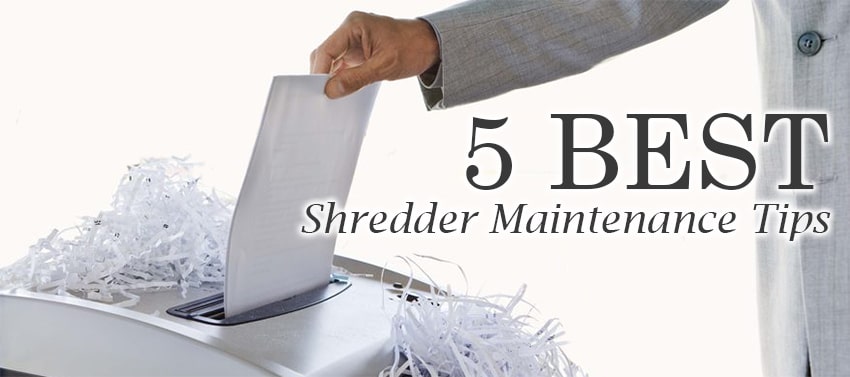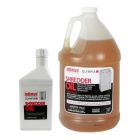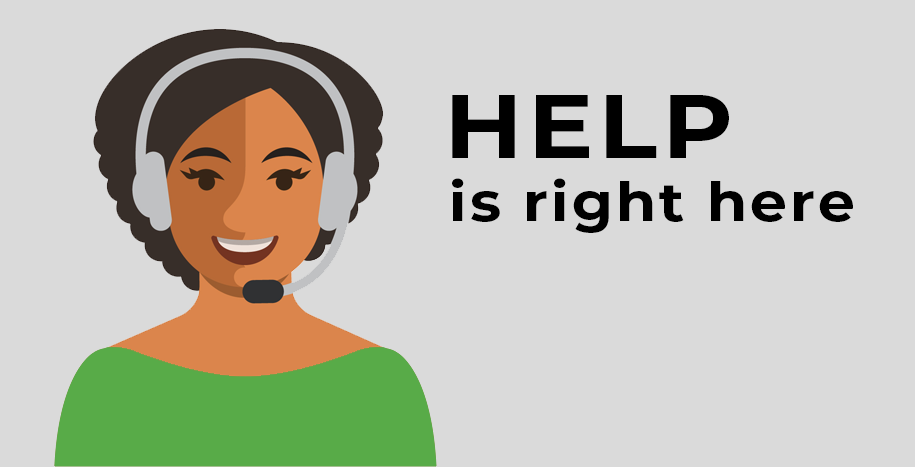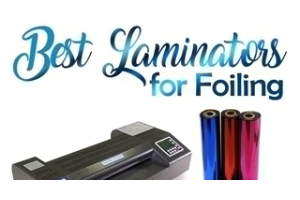5 Best Shredder Maintenance Tips

In order to keep your paper shredder running at peak performance, as well as to reduce unnecessary or pre-mature wear to the motor and mechanisms, some minor maintenance tasks can be utilized. In general, these tips apply across-the-board for all paper shredders, no matter if they are small individual-level, or large industrial machines. It doesn't matter which kind of shredder you have, what brand, or what security level -- taking basic maintenance steps can make a huge difference in performance, as well as the longevity of your machine.
1. Keep your Shredder Lubricated
Oiling your shredder is another important maintenance step to keep your shredder running at its best. You wouldn't drive a car or use a machinery without properly lubricated necessary components, and you shouldn't use a shredder either. Without lubrication, excess heat can be generated, and blades can rub against each other more roughly. A properly oiled shredder will be quieter, run smoother, and reduce unnecessary strain to the motor and cutting cylinders.
There are several methods for oiling a shredder, so you can choose what works best. You should also check your user manual, as they may have a specific method recommended for that unit, which should be your primary go-to choice at all times. You can also check your instruction manual for recommended oil frequency. A good general rule-of-thumb is to oil each time your bin is full and needs to be emptied. Some shredders, like micro cross cuts (P-5, P-6, P-7 security levels) may require more frequent oiling, while strip cuts (P-1, P-2) may require less-frequent. You will know that your paper shredder is past its due-date for oiling if you notice it running slower than normal, making odd noises, or straining to shred.
Option 1: Direct Oiling
- Start by pressing "reverse" to eject any stuck paper.
- Dispense oil directly into the cutting feed, from one end to the other in one smooth motion.
- Turn on the shredder to help disperse the oil throughout the cutter (without paper).
- Run a couple of clean paper sheets to help clean off excess oil.
Option 2: Lubricated Paper
- Run oil down the sides of a sheet of paper. Don't completely soak it. Place a blank sheet on top, sandwiching the oil.
- Be careful not to drip oil from the paper, and run it through the shredder as normal.
- Run a couple of clean sheets to help clean off excess oil.
Option 3: Wax Paper
- You can get wax paper from almost anywhere, and it is a nice alternative to oil. Just run the wax paper through your shredder as you would normal paper. Depending on the frequency, one or two sheets will help to lubricate the cutting cylinders.
TIP: Not all shredders require oil anymore. If you're shopping for a shredder, consider looking for an "oil-free" option. Dahle has several. Not only does this eliminate the hassle of the above steps, but it reduces your environmental impact since oil is not good for our eco-system.
TIP: Only use shredder oil that has been specifically manufactured for paper shredding machines. Using oils not made for shredders, such as WD-40 or cooking oils, can be a fire danger. It can also cause paper to stick together and jam in the cylinders. Fixing a jam like that is incredibly difficult and time-consuming, and may even irreparably damage the cutting unit.
TIP: Some larger paper shredders either come with, or have the option to add, automatic oilers. This is incredibly convenient for the office environment where there will be many users daily.
2. Keep your Shredder Clean
Depending on your volume of use, a paper shredder in a business-environment is recommended to be cleaned every month or so. For individuals who use a personal shredder less-often, every several months or even annually may be acceptable. Cleaning your shredder is simple, with just a few steps to take, and can help remove stuck paper from your cutting cylinders. This will help extend the life of the blades, keeping them sharp and unhindered. It will also remove paper dust build-up, which may not be plainly visible, but can be detrimental to your shredder if it builds up thick. Not to mention paper dust is bad for air quality.
- Turn off your shredder and unplug it.
- Open the machine cover, using the assistance of your user manual, if necessary.
- Be VERY careful when accessing the blades; they are incredibly sharp. Use a brush to dust off the blades as best you can.
TIP: Don't blow into the cutting shaft; saliva particles and moisture can cause irreparable damage to the metal components.
TIP: You can help reduce paper dust build up by using a shredder bag or box. I prefer non-plastic solutions, like boxes and paper bags, but whatever you choose, this can help keep dust particles better contained.
3. Don't Overload your Shredder
When you bought your shredder, you may have considered the shredding capacity as a factor. Perhaps it was a 6-sheet shredder, or maybe a 20-sheet. Remember, this specification is the maximum capacity it can handle at any one time, and it is also most often based on thin copy paper stocks. It is never a good idea to always run your shredder at full-capacity. As you can imagine, driving a car at its top speed (perhaps that is 150mph) all the time would wear down your motor pretty quickly. The same is true for office equipment, including paper shredders. While it may be able to handle X number of sheets per pass, that doesn't mean you should always run X sheets.
Your shredder may also have an indicated "maximum run time" listed in the user manual. A smaller shredder may have a run time of 10 minutes, or a larger one of 30 minutes or more. This refers to continuous shredding. When this time is met, it is time to pause your shredding and allow the machine time to cool (see number 4) before beginning again.
This also means you should only shred materials that your model can accept. Some shredders will only take paper, whereas others can take credit cards and even CDs or other discs. Never shred anything that your machine is not rated for; this can cause expensive or irreparable damage to the cutting unit and overload the motor. That means that, if you are shredding stapled pages and your shredder cannot accept staples, you need to remove all staples before proceeding with the shredding. This also means you need to remove any adhesive prior to shredding, such as address labels, stamps, or stickers, as the adhesive can gum-up the cutter.
4. Allow for Cool-Down Time
After shredding many pages in a batch, you should give your machine a couple moments to cool down. The amount of time to cool off will vary depending on (a) the shredder model that you have, and (b) how long you had it shredding sheets continuously. Personal shredders will often need more cool-off time, as the motors are not build to handle larges volumes, whereas larger office-level machines may just need 30 seconds or a minute, less frequently. As always, you should check your user manual to see what the manufacturer recommends for your specific unit.
5. Unplug your Shredder when not in-use
When your shredder is plugged in, it uses power. Even when not in use, simply being plugged in drains a small amount of power. In addition to the additional electricity use, if you have an automatic-mode shredder, this keeps the motor on and running (to an extent) which wears it down. When your shredder is not in use (for example, at the end of the work day or before the weekend), be sure to unplug it from its power source.
For more information or a quote, call us at
(866) 537-2244
or email
info@buy101.com
 About the Author • Mallory Morsa has been part
of Binding101 since 2008 and she is the primary content creator for BUY101® information. She began in customer
service and sales where she honed in her skills to provide the customer with professional, fast, and accurate
information. Shortly after, she was promoted to sales supervisor and also took on the role of product expert,
training the team on new products. Throughout this time, she also wrote content for the site, as well as contributed
stock photography and videography. As the team grew, she moved to an official position as the content specialist and
social media manager. Her skills in these variety of areas give her the unique expertise to not just create content
for the web, but to create content for you, the customer. She has a Bachelor's degree in business management and
marketing, was on the Dean's List each year, and graduated Summa Cum Laude. In her free time, Mallory's favorite
things to do include volunteering at the animal shelter by bottle feeding neonatal kittens, reading at the park,
cooking plant-based meals, playing board games, hiking, and binge streaming TV shows with her furbabies and family
beside her.
About the Author • Mallory Morsa has been part
of Binding101 since 2008 and she is the primary content creator for BUY101® information. She began in customer
service and sales where she honed in her skills to provide the customer with professional, fast, and accurate
information. Shortly after, she was promoted to sales supervisor and also took on the role of product expert,
training the team on new products. Throughout this time, she also wrote content for the site, as well as contributed
stock photography and videography. As the team grew, she moved to an official position as the content specialist and
social media manager. Her skills in these variety of areas give her the unique expertise to not just create content
for the web, but to create content for you, the customer. She has a Bachelor's degree in business management and
marketing, was on the Dean's List each year, and graduated Summa Cum Laude. In her free time, Mallory's favorite
things to do include volunteering at the animal shelter by bottle feeding neonatal kittens, reading at the park,
cooking plant-based meals, playing board games, hiking, and binge streaming TV shows with her furbabies and family
beside her.












